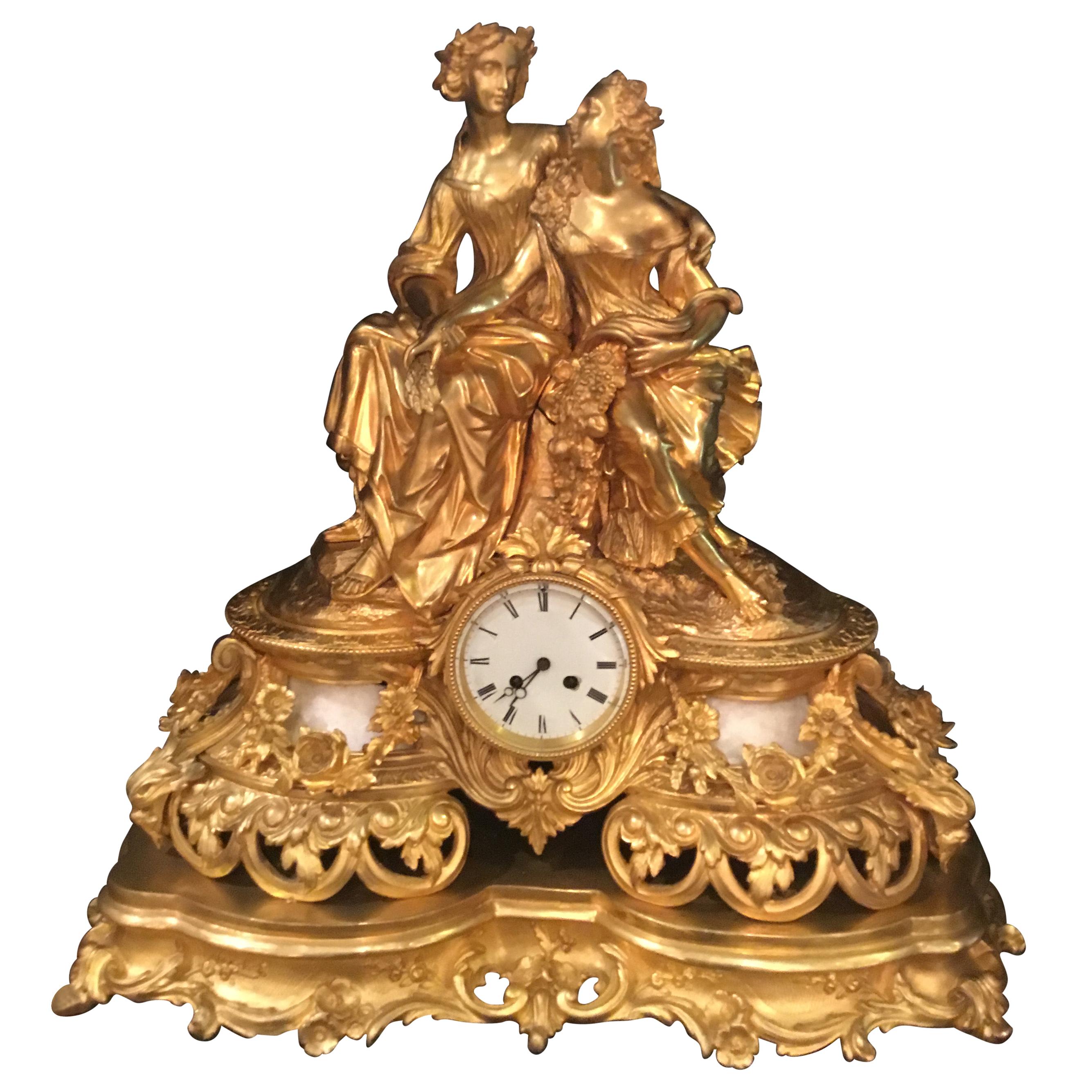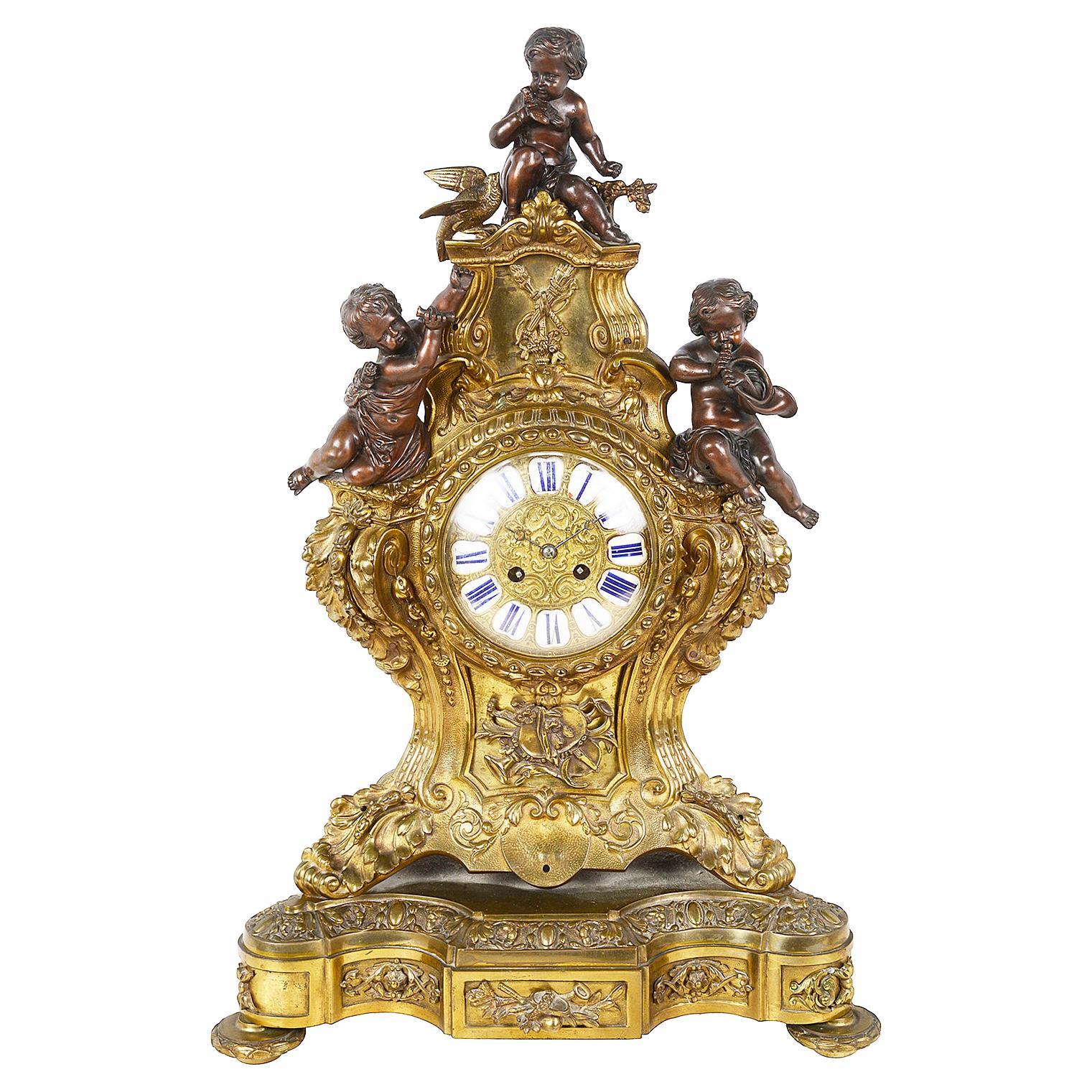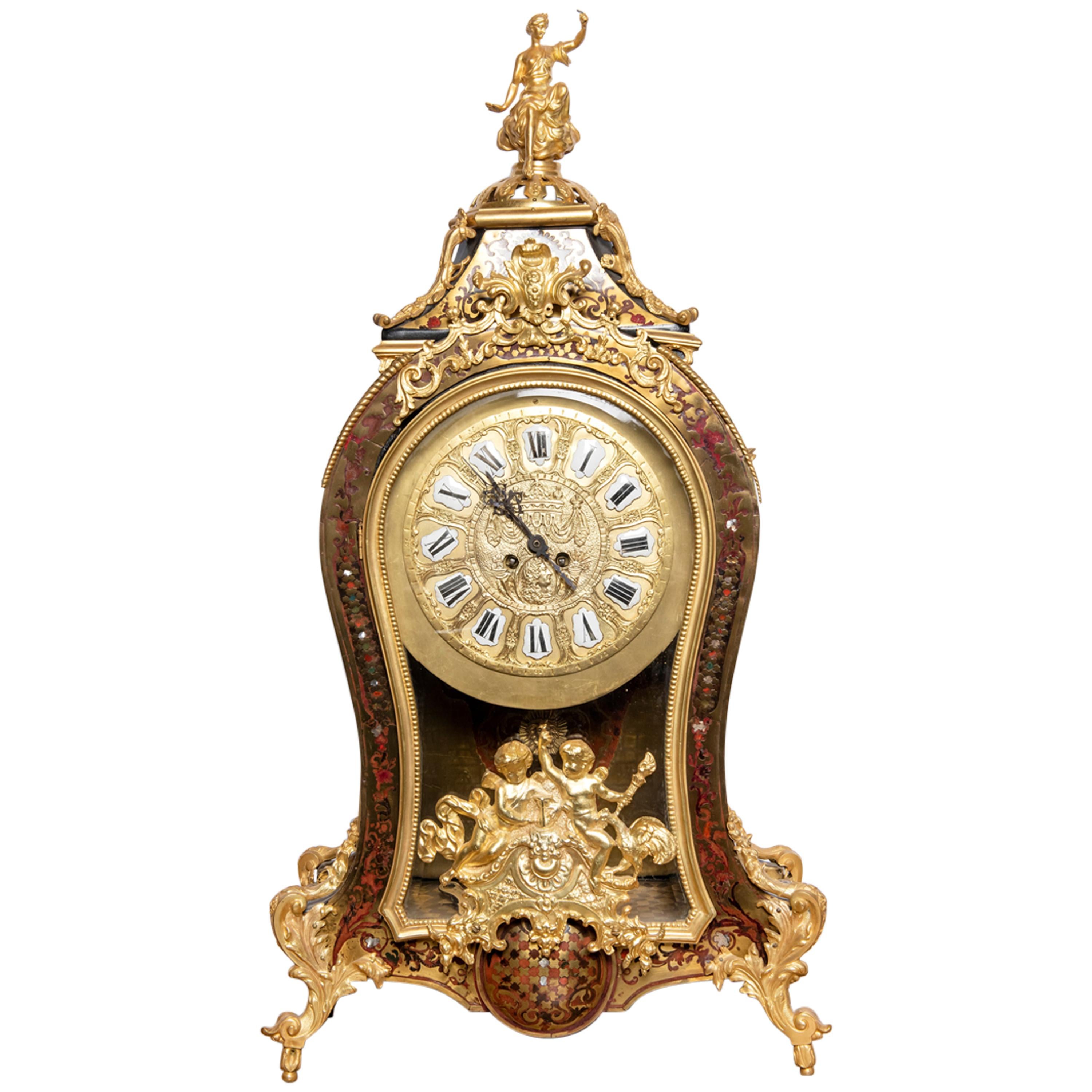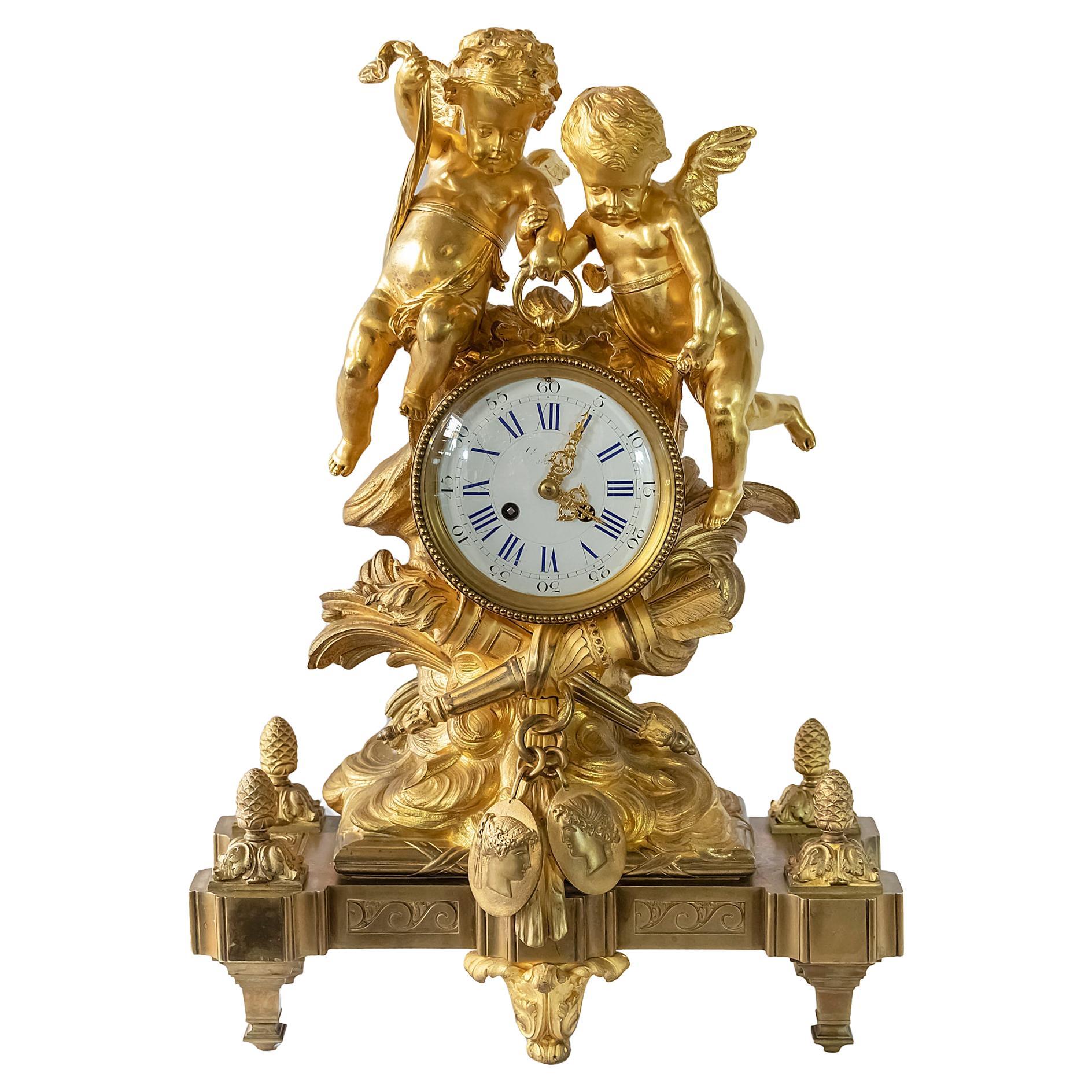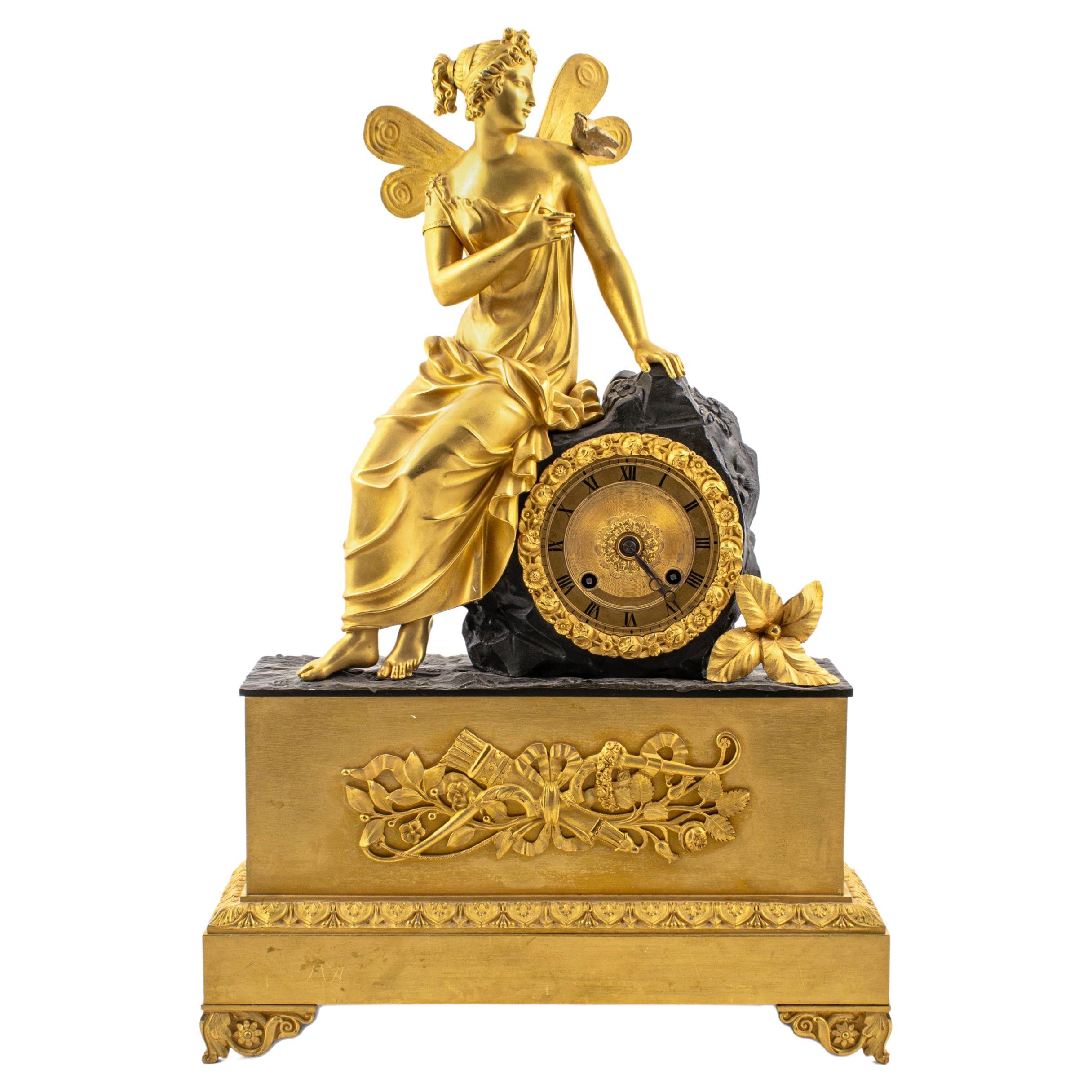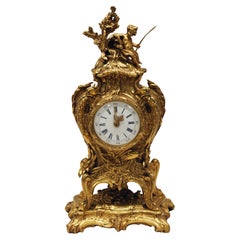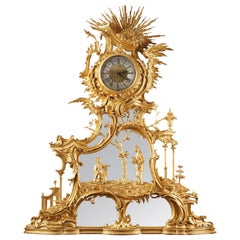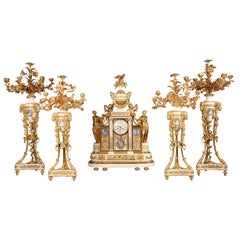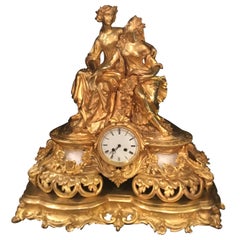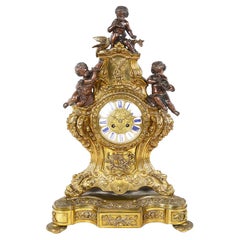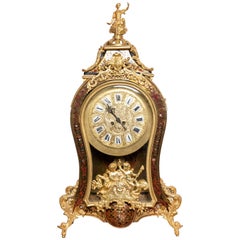Items Similar to Leila and the Giaour Gilded Bronze Clock, France, Circa 1830
Want more images or videos?
Request additional images or videos from the seller
1 of 14
Leila and the Giaour Gilded Bronze Clock, France, Circa 1830
$12,788.47
$29,010.8855% Off
£9,676.40
£21,951.0855% Off
€10,800
€24,50055% Off
CA$17,902.77
CA$40,612.7655% Off
A$19,526.47
A$44,296.1655% Off
CHF 10,288.78
CHF 23,340.3055% Off
MX$234,174.45
MX$531,229.0855% Off
NOK 129,548.92
NOK 293,884.1255% Off
SEK 120,866.52
SEK 274,187.9455% Off
DKK 82,270.08
DKK 186,631.1955% Off
About the Item
Dial signed Polti Frères
Measures: With base or glass: Height 61 cm (24 in.), width 51,5 cm (20.3 in.), depth 23.5 cm (9,2 in.)
Without base: Height 52 cm (20,5 in.), width 42 cm (16.5 in.), depth 12.5 cm (4.9 in.)
Important philhellenic clock in burnished and amati gilded bronze, finely chiseled, representing on the terrace a couple elegantly dressed in "the turkish style", and richly decorated with foliage, scrolls and flowers. The feet, decorated with water leaves, rest on an oval wooden base covered with a globe.
The theme of the clock comes from The Giaour, a fragment of a Turkish Tale, an English poem by Lord Byron published in may 1813 which tells the thwarted love of a Venetian, the Giaour – term by which the Turks designate infidels and especially Christians – and of Leila, a slave belonging to Hassan’s seraglio, military leader of a Turkish province. The betrayal of Leila discovered, she will be thrown into the sea and her lover will avenge her by killing Hassan, then taking refuge in a monastery.
Symbol of prestige and modernity, the decorative clocks are a reflection of the taste of the era of a wealthy bourgeoisie and may be the subject of diplomatic gifts or between individuals.
Beyond the purely decorative aspect of such objects, watchmaking in the 19th century is part of a subtle mix of political, historical and literary references.
This philhellenic movement converning the West finds a particular echo in France, one of the countries with the United Kingdom and Russia having suported the Greeks during their war of independance (1821-1830) to free oneself from the grip of the Ottoman Empire. Many clocks have been made, highlighting the courage of the fighters, celebrating the heroes of this war of independence and exalting national sentiment, inspired by contemporary literature evoking these events.
Related work :
Leila and the Giaour clock Gilded bronze, H. : 58 cm Reproduced in Les heures du Philhellénisme, les pendules philhelléniques françaises, Stéphan Adler, Editions Olkos, Athènes, 2018, p.271 (photo n°1).
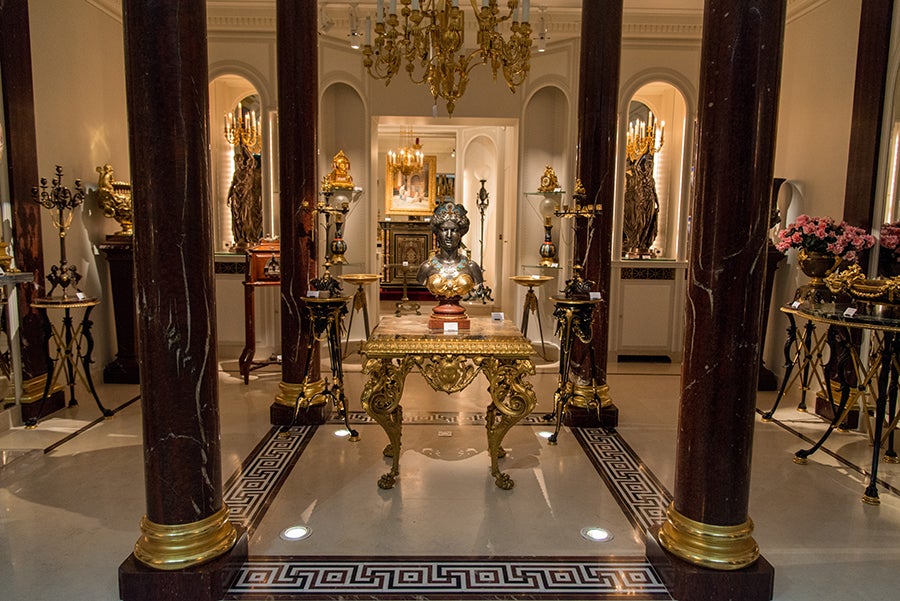
About the Seller
4.9
Gold Seller
Premium sellers maintaining a 4.3+ rating and 24-hour response times
Established in 1997
1stDibs seller since 2018
91 sales on 1stDibs
Typical response time: 2 hours
Associations
International Confederation of Art and Antique Dealers' Associations
- ShippingRetrieving quote...Shipping from: PARIS, France
- Return Policy
More From This Seller
View All"The Source" Gilt bronze Clock attr. to L. Messagé & F.Linke, France, circa 1890
By François Linke
Located in PARIS, FR
Charming clock in the shape of a Rocaille-inspired cartel in chiseled and gilded bronze. Scalloped marine-inspired decor representing a trophy with oars, dolphins, reeds and flowers ...
Category
Antique 1890s French Rococo Revival Table Clocks and Desk Clocks
Materials
Bronze, Enamel
"Chinese" Giltwood Clock After a Design by Thomas Johnson, England, circa 1860
By Thomas Johnson, London 1
Located in PARIS, FR
Important giltwood clock with a mirror background of Rococo inspiration with a rich sinuous and asymmetrical decoration representing a Chinese couple ab...
Category
Antique 1860s English Chinese Chippendale Mantel Clocks
Materials
Giltwood
Ormolu Clock "with a Swing", France, circa 1820
Located in PARIS, FR
Very fine floral and decorated Restauration period ormolu clock, figuring two baluster columns joint together by a floral arch, and topped by a crown of roses. Roman numbers indicate...
Category
Antique 1820s French Restauration Mantel Clocks
Materials
Bronze
Important Five Pieces Marble and Gilded Bronze Clock Set, France, Circa 1860
By Henri Picard
Located in PARIS, FR
Marked on the dial Furet & Bon, Hrs du Roy, à Paris
Measures: Clock – Height 98 cm (38 1/2 in.), width 70 cm (27 1/2 in.), depth 25 cm (9 3/4 in.)
Candelabra – Height 116 cm ...
Category
Antique 1860s French Louis XVI Mantel Clocks
Materials
Marble, Bronze
"Geniuses of the Arts" Gilded Bronze and Marble Clock Set by G. Fabre, c. 1900
By Samuel Marti, G. Fabre
Located in PARIS, FR
Dial signed G. Fabre, 4 rue des Filles du Calvaire, Paris
Clockwork signed Samuel Marti – Médaille d’Or 1900
A Louis XVI style gilt-bronze and statuary Carrare marble clock set, consisting of a clock and a pair candelabra...
Category
Antique Early 1900s French Louis XVI Mantel Clocks
Materials
Marble, Bronze
Neo-Egyptian Bronze and Marble Clock Attributed to G.Servant, France, Circa 1870
By Georges Emile Henri Servant
Located in PARIS, FR
A black and red marble clock in the shape of an Egyptian temple attributed to G. Servant, flanked by double columns inscribed with hieroglyphs and ornated with a winged uraeus, all made in two patina bronze. The clock is surmounted by a patinated bronze sphinx. Resting on four bronze faces wearing the nemes and terminating in lion paw feet.
Georges Emile Henri Servant (circa 1828-1890) who took over his father in 1855 at their foundry, rue Vieille-du-Temple, in Paris, specialized in the production of neo-Egyptian style clocks, very popular in France since 1860s, and also the making of Greek style decorative objects. He drew considerable attention to the high quality of his bronzes at the 1855 Paris Universal Exhibition and then at the 1862 London Exhibition. At this time Servant exported up to 40% of his production, principally to the United States, where for instance, his sphinx clocks were sold with great success by Louis Tiffany Inc. or Hamann & Roche of New York (A similar clock is now exposed at the Metropolitan Museum of Art, New York). But his success came really at the 1867 Paris Universal Exhibition, where he was awarded a gold medal for his neo-Greek and Egyptian works (Les Merveilles...
Category
Antique 1870s French Egyptian Revival Mantel Clocks
Materials
Marble, Bronze
You May Also Like
Elegant and Large Gilt Bronze French Clock
Located in Houston, TX
Large and impressive! Gilt bronze and white marble clock
Which consists of a lovely figural statue which sits above
A clock that has a white enamel face and Roman numerals.
The fi...
Category
Antique Late 19th Century French Table Clocks and Desk Clocks
Materials
Bronze
$13,600 Sale Price
30% Off
19th Century Gilded Ormolu and Bronze Mantel Clock
Located in Brighton, Sussex
An impressive late 19th century French gilded ormolu and patinated bronze mantel clock. Having three putti mounted to the top each playing musical instruments. The clock having an ei...
Category
Antique Late 19th Century French Louis XVI Mantel Clocks
Materials
Bronze, Ormolu
Gilt Bronze and Wood Table Clock, France, Late 19th Century
By Ecole Boulle
Located in Buenos Aires, Buenos Aires
Gilt bronze and wood table clock, France, late 19th century.
Category
Antique Late 19th Century French Louis XV Table Clocks and Desk Clocks
Materials
Bronze
Antique 19th Century French Gilded Bronze Mantel Clock
Located in Vilnius, LT
Large antique 19th century French gilded bronze mantel clock surmounted with two angels holding the dial.
The enamel dial numerals are hand...
Category
Antique 19th Century French Mantel Clocks
Materials
Bronze, Enamel
Rare French Empire Clock in Gilt and Patinated Bronze Signed Lepaute
By Jean-André Lepaute 1
Located in Vancouver, British Columbia
An extremely rare and important French Empire mantle clock signed by the master clock making dynasty of Jean-Andre Lepaute and his brother Jean-Baptiste Lepaute.
The case, in the form of an antique portal...
Category
Antique Early 19th Century French Empire Mantel Clocks
Materials
Bronze
Louis Phillippe Bronze Clock, France, c 1830-1840
Located in Kastrup, DK
Louis Phillippe gilded and dark patinated bronze clock.
Young woman adorned with wings and a bird on the shoulder sitting on rock block.
Gilt dial with wreath of flowers.
Included ke...
Category
Antique Mid-19th Century French Louis Philippe Mantel Clocks
Materials
Bronze
More Ways To Browse
Gilded Clock
French Wood Clocks
Mantel Clock Wood
Pendule Antique
Gilded Bronze Clocks
French Gilded Antique Clocks
Gilded French Clock
Gilded Bronze Mantel Clock
Globe Clock
H H French Wood Mantel Clocks
Ottoman Clock
Marble Based Bronze Mantel Clock
19th Century Black Mantel Clock
French Empire Gilt Bronze Clock
Gilded Clock
Antique French Brass Clocks
French Empire Mantel Clock
Rococo Ormolu
